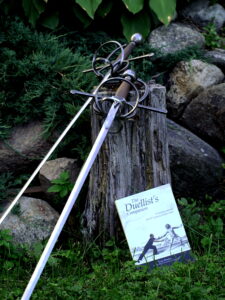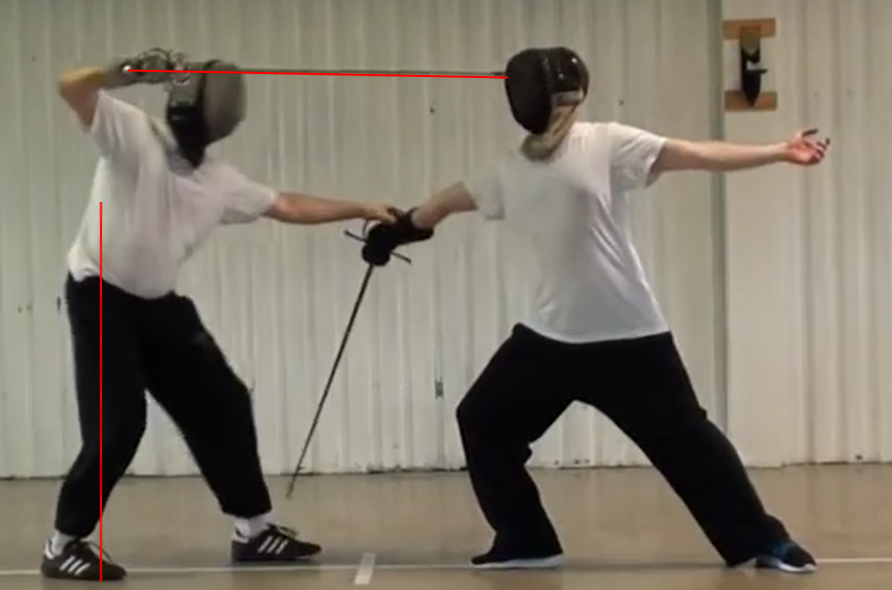Rapier Length: responding to criticism from the internet

As you may know, I am in the process of videoing everything we do in the salle, and putting it up online for free. This project is called the “Syllabus Wiki“. One of the many benefits of this is that informed commentators can see what we are doing and make constructive criticisms, which leads to improvement in our interpretations and methods. Not all criticism is well-meant, or well-written, but I do my best to stick to the facts, and ignore any agenda the critic may have. The truth of the Art should outweigh any other factor.
We have been putting a lot of Capoferro rapier material up lately; we have recently uploaded the last of the plays of the sword alone, shown on Plate 20. Bear in mind that these videos are intended to show a co-operative, choreographical rendition of the contents of the plate; they do not go into hard and fast applications of the lessons of the plates, or show anything against a non-compliant opponent.
One anonymous blogger, who goes by “Grauenwolf”, has recently taken issue with quite a few of our videos, and in some cases he has a point. [There is actually quite a lot of interesting material on his blog, which has been going since 2008.] I would find the criticisms more useful if they were accompanied by video examples of Grauenwolf himself doing the same actions his way, but at least he is quoting from the sources, and seems to truly care about historical accuracy.
One such critique is here, regarding rapier length, in which he states his opinion that we are using blades that are much too short. He doesn’t actually tell us how long our blades should be, but does quote from Capoferro’s passage (using Wilson and Swanger’s translation without attribution):
“Therefore the sword has to be twice as long as the arm, and as much as my extraordinary pace, which length corresponds equally to that which is from my armpit down to the sole of my foot.”
He includes this screenshot from our video (again without attribution, but at least in this case anyone who checks the video link will find out whose video it is), with lines added to indicate his point of disagreement (if only all disagreements were so clearly stated!).
As you can see, Henry's sword is clearly shorter than the distance from his armpit to the floor. But the passage is not quite as straightforward as all that. The arm is presumably measured from the armpit; but to the wrist, or the fingertips? The “extraordinary pace” is measured from where to where?
The only apparently simple measurement is from armpit to the sole of the foot, presumably while standing (and incidentally is the same length of sword that Vadi recommends). The problem is that it would make for a sword that is much longer than most surviving examples, and much longer than the ones that are apparently illustrated. I have addressed the problem of rapier length in print twice before, in The Duellist’s Companion, and in Choosing a Sword. To quote from the latter:
In my opinion, Capoferro’s system works best with a sword that weighs between 1kg and 1.6kg (2.0—3.5 lb), with the point of balance between 6 and 15 cm (2.5—6 inches) in front of the crossguard, a complex hilt that allows you to put your forefinger over the crossguard safely, and a blade length from crossguard to point of at least 97 cm (38”) (for short people), up to a maximum of about 114 cm (45”).
Capoferro himself tells us, in Chapter III: The Division of Fencing That is Posed in the Knowledge of the Sword, section 36:
“Therefore the sword has to be twice as long as the arm, and as much as my extraordinary pace, which length corresponds equally to that which is from my armpit down to the sole of my foot.” (Translation by William Wilson and Jherek Swanger).
I have never met anyone for whom those three measurements were the same, and in my The Duellist's Companion I worked them out like so:
“My arm is 52 cm, shoulder to wrist; my lunge about 120 cm from heel to heel, and it is about 140 cm from my foot to my armpit when standing. When standing on guard, it is about 115cm from foot to armpit. When in the lunge, it is about 104 cm from foot to armpit. Also, it is not clear whether he refers to the length of the blade, or of the whole sword.
If we resort to the unreliable practice of measuring the illustrations, in the picture of the lunge, the sword blade is 73 mm, the arm from wrist to armpit 37 mm, and the line G (front heel to front armpit) 55 mm. The distance between the feet is 67 mm.
So, the measurement most consistent with the text would appear to be the length of the arm, from wrist to armpit, as it approximately correlates to half the length of the blade. Given this as a guide, my blade ought to be 104 cm or about 41” long from the guard to the point.”
So there are three critical measurements:
- the length of the arm
- the length of the “extraordinary pace”
- the length from the armpit to the sole of the foot.
Henry, the chap in the illustration, has the following measurements:
- Arm from armpit to wrist: 49cm. From armpit to fingertip, 66cm.
- In guard, armpit to sole of the foot: 122cm; standing, 150cm.
- His lunge is 100cm heel to heel, and 130cm from the back heel to the front toes.
- His sword has a blade length of 107cm (a touch over 42”), and a total length of 122cm.
For what it's worth, modern manufacturers of rapier blades tend to offer them between 40 and 45″ (102cm- 114cm); a 150cm rapier would have a blade of about 135cm, or 53″.
So, given these measurements, I would be very interested to hear how long Henry’s sword should be, based on Grauenwolf's interpretation. I would also like to know Grauenwolf’s measurements, and the length of his sword, and see how he has solved the knotty problem of reconciling three quite different measurements.
[“Grauenwolf” goes on to criticise the way we beat the sword, apparently completely oblivious to the fact that Janne is co-operating in a way that the combatants illustrated in Gran Simulacro are not, and also oblivious to the purpose of the video. But that’s a whole other story. At least our videos are doing what they are intended to do: making it easier for people to get to grips with the source material; in this case, providing the impetus for a whole list of blog posts. Sure, I’d rather they were a bit more constructive, but anything that gets the sources talked about has to be a good thing.]
I have a strict policy on the internet: I never link to bad things. In other words, if somebody has annoyed or disgusted me, I don't reward them with traffic. So you might wonder why I am sending traffic Grauenwolf's way. Simply, it's because
a) I'm not annoyed or disgusted; if nobody ever disagreed with me, I'd never learn anything;
b) his blog has a lot of good and interesting stuff on it;
c) while I obviously don't agree with him on this point, and think he could be better at attributing his sources, I think his critique is an attempt to serve the Art, not to advance a personal agenda, and
d) I really do want to know how he solves the problem of the three incompatible measurements.
We have an entirely different issue regarding longsword length. You can find that discussion here.
How to hold the sword is another matter too. You can find that discussion here.

